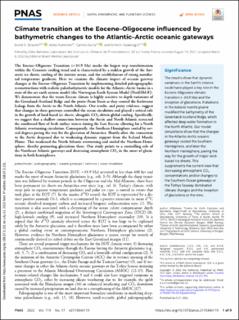| dc.contributor.author | Straume, Eivind Olavson | |
| dc.contributor.author | Nummelin, Aleksi Henrynpoika | |
| dc.contributor.author | Gaina, Carmen | |
| dc.contributor.author | Nisancioglu, Kerim Hestnes | |
| dc.date.accessioned | 2022-08-03T12:18:46Z | |
| dc.date.available | 2022-08-03T12:18:46Z | |
| dc.date.created | 2022-05-11T11:14:16Z | |
| dc.date.issued | 2022 | |
| dc.identifier.issn | 0027-8424 | |
| dc.identifier.uri | https://hdl.handle.net/11250/3009968 | |
| dc.description.abstract | The Eocene–Oligocene Transition (∼33.9 Ma) marks the largest step transformation within the Cenozoic cooling trend and is characterized by a sudden growth of the Antarctic ice sheets, cooling of the interior ocean, and the establishment of strong meridional temperature gradients. Here we examine the climatic impact of oceanic gateway changes at the Eocene–Oligocene Transition by implementing detailed paleogeographic reconstructions with realistic paleobathymetric models for the Atlantic–Arctic basins in a state-of-the-art earth system model (the Norwegian Earth System Model [NorESM-F]). We demonstrate that the warm Eocene climate is highly sensitive to depth variations of the Greenland–Scotland Ridge and the proto–Fram Strait as they control the freshwater leakage from the Arctic to the North Atlantic. Our results, and proxy evidence, suggest that changes in these gateways controlled the ocean circulation and played a critical role in the growth of land-based ice sheets, alongside CO2-driven global cooling. Specifically, we suggest that a shallow connection between the Arctic and North Atlantic restricted the southward flow of fresh surface waters during the Late Eocene allowing for a North Atlantic overturning circulation. Consequently, the Southern Hemisphere cooled by several degrees paving the way for the glaciation of Antarctica. Shortly after, the connection to the Arctic deepened due to weakening dynamic support from the Iceland Mantle Plume. This weakened the North Atlantic overturning and cooled the Northern Hemisphere, thereby promoting glaciations there. Our study points to a controlling role of the Northeast Atlantic gateways and decreasing atmospheric CO2 in the onset of glaciations in both hemispheres. | en_US |
| dc.language.iso | eng | en_US |
| dc.publisher | National Academy of Sciences | en_US |
| dc.rights | Navngivelse 4.0 Internasjonal | * |
| dc.rights.uri | http://creativecommons.org/licenses/by/4.0/deed.no | * |
| dc.title | Climate transition at the Eocene-Oligocene influenced by bathymetric changes to the Atlantic-Arctic oceanic gateways | en_US |
| dc.type | Journal article | en_US |
| dc.type | Peer reviewed | en_US |
| dc.description.version | publishedVersion | en_US |
| dc.rights.holder | Copyright 2022 The Author(s) | en_US |
| dc.source.articlenumber | e2115346119 | en_US |
| cristin.ispublished | true | |
| cristin.fulltext | original | |
| cristin.qualitycode | 2 | |
| dc.identifier.doi | 10.1073/pnas.2115346119 | |
| dc.identifier.cristin | 2023428 | |
| dc.source.journal | Proceedings of the National Academy of Sciences of the United States of America | en_US |
| dc.identifier.citation | Proceedings of the National Academy of Sciences of the United States of America. 2022, 119 (17), e2115346119. | en_US |
| dc.source.volume | 119 | en_US |
| dc.source.issue | 17 | en_US |

